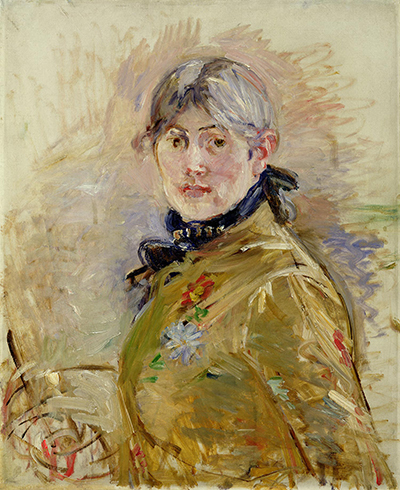The most famous painting of Berthe Morisot was actually produced by Edouard Manet but the artwork that we have in front of us here was a rare self portrait from her own hand.
This item came about in 1885 and can today be found in the Musée Marmottan Monet in Paris, France. The artist looks directly at us within this composition and features a mustard-coloured jacket with black scarf. Her hair is grey and looks pragmatically styled to allow her to focus on her painting without any distractions. One can see immediately that she is somewhat older than in Manet's version, though the same facial structure is still present. Behind her the painting is unfinished, with a flurry of paint which surrounds the subject but does not continue to the edges of the painting. Perhaps she is at work herself here, and often self portraits of artists would feature themselves by an easel, in order to remind everyone about their occupation in life. This feels like either a study in oils, or an unfinished painting and it is hard to decide which.
Artists would often lose interest in a painting and then leave it half finished, but it is hard to imagine her doing so with a self portrait. Morisot would regularly amend her work many times over, suggesting a desire for near perfection, and so it might be possible that she chose to adandon the whole piece. The artist would not pass away from another decade yet, and so there was no possibility of ill health causing this project to be closed down. Therefore, perhaps simply this was a rare opportunity to depict herself purely for the entertainment, and she never intended this piece to be entirely finished nor sold on. She did produce a number of self portrait sketches, again perhaps because of the accessible nature of herself as a subject, offering opportunities to work whenever the whim took her.
Morisot much preferred to paint others within her work and was not someone who reflected on herself too much. Some artists have actually specialised in self portraiture for long periods of their career, but it surely can't be healthy to concentrate on oneself intensely for an extended period of time. Morisot regularly asked friends and family to pose for her and these produced some of the most intimate portraits from her career, particularly those where young children were included alongside their mothers. She also featured women in a variety of poses and activities, aiming to reflect their role in society in a positive manner and this genre would became the most prevalent within her career.




